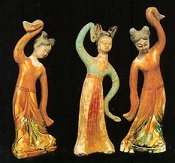|
被禁止的性行為與性暴力
|
|
賣淫: 有關的歷史記載
1
|
|
 |
|
舞妓
中國陶塑(唐三彩,西元8-9世紀)(蒙中國古代性文化博物館惠允,江蘇省吳江市同裏鎮。) |
|
Dancing Prostitutes
Chinese porcelain figures,
8th.- 9th centy AD.
(Courtesy China Sex Museum, Tongli) |
|
賣淫常常被稱為“世界上最古老的職業”,甚至自從遠古以來就已存在。在古代的近東,賣淫甚至以宗教的面貌出現,那時,為配合對生殖神的祭拜和祈求豐收,“祭祀妓女(sacred
prostitute)”就會去寺廟(賣淫)。然而,我們從《聖經》中獲知,這種祭祀儀式的“寺廟賣淫”曾經受到猶太人的猛烈譴責。儘管如此,賣淫以褻瀆的方式依然風行於整個古代社會。因而,當考古學家挖掘(古)羅馬的城市龐培(於西元79年被火山所摧毀)的時候,他們發現數個妓院其中之一刻有碑銘“宿樂苑(Hic
habitat felicitas)”而並不感到吃驚。在中世紀的歐洲,按照聖·湯瑪斯·阿奎奈(St.
Thomas Aquinas)的觀點,賣淫得到官方批准;他的觀點認為,廢除賣淫將在社會造成混亂,而且“甚至一座宮殿也需要下水道”。在帝制的中國,在數個世紀裏賣淫由官衙所管理,最終幾乎成為永續的私營妓業。但是,1949年,隨著中華人民共和國的建立,賣淫不合法了。實際上,中國歷史上,一直就存在一而再、再而三取締賣淫的嘗試,但是,最終都歸於失敗。其它國家也是如此。例如,美國在第一次世界大戰後關閉了合法的妓院,但是,只有產生了諸如從“休閒吧”與“按摩院”到“站街女”、“應召女郎”和“陪同服務”等新型賣淫形式之後,才得以成功。在歐洲,現今實行兩種相反的策略:逮捕妓女的主顧(瑞典)或把賣淫變成含有健康保險和退休金保障的“正規工作”(荷蘭)。後一種策略似乎在多數歐洲國家正在普遍實行。
因為可以容易在其它文獻裏查閱到賣淫史,本教程將只對那些仍與現時社會環境有關的方方面面的賣淫現象做簡短概述。 |
|
Prohibited Sexual Behavior and Sexual Violence
|
|
Prostitution: Historical Note
|
Prostitution has often been called “the world’s oldest profession”, and indeed it has existed since time immemorial in all ancient and modern
civilizations. In the ancient Near East, it even had a religious aspect when “sacred prostitutes” worked in the service of a fertility goddess and their earnings went to the temple. However, we know from the Bible that this ritualistic “temple prostitution” was vehemently condemned by the Israelites. Nevertheless, in its profane form, prostitution flourished throughout the ancient world. Thus, when archeologists excavated the Roman city of Pompeii (destroyed in 79 A.D.) they were not surprised to find several brothels, one of them with the inscription “Hic habitat felicitas” (Here dwells happiness). In medieval Christian Europe, prostitution was officially tolerated according to the view of St. Thomas Aquinas that abolishing it would create disorder in the community and that “even a palace needs sewers”. In imperial China, prostitution was, for centuries, regulated by the government, but eventually became an ever-expanding private enterprise. With the founding of the People’s Republic in 1949, however, prostitution became illegal. Actually, in the course of Chinese history, there had already been repeated attempts to eliminate prostitution, but they had all proved futile in the long run. This is also true of other countries. The USA, for example, closed its legal brothels after World War I, but succeeded only in creating new forms of prostitution, from “pick-up bars” and “massage parlors” to “streetwalkers”, “call girls” and “escort services”. In Europe, two opposite strategies are being pursued today: Arresting the customers of prostitutes (Sweden) or turning prostitution into a “regular job” with health insurance and pension plan (Netherlands). This latter approach seems to be gaining ground in most other European countries.
Since the history of prostitution can easily be researched elsewhere, this course will offer only a few brief notes about some of its aspects that are still relevant to the current situation. |